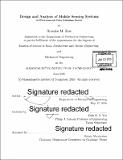| dc.contributor.advisor | Dick K. P. Yue. | en_US |
| dc.contributor.author | Zoss, Brandon M | en_US |
| dc.contributor.other | Massachusetts Institute of Technology. Department of Mechanical Engineering. | en_US |
| dc.date.accessioned | 2016-09-13T19:19:35Z | |
| dc.date.available | 2016-09-13T19:19:35Z | |
| dc.date.copyright | 2016 | en_US |
| dc.date.issued | 2016 | en_US |
| dc.identifier.uri | http://hdl.handle.net/1721.1/104269 | |
| dc.description | Thesis: S.M. in Naval Architecture and Marine Engineering, Massachusetts Institute of Technology, Department of Mechanical Engineering, 2016. | en_US |
| dc.description | Thesis: Mech. E., Massachusetts Institute of Technology, Department of Mechanical Engineering, 2016. | en_US |
| dc.description | Cataloged from PDF version of thesis. | en_US |
| dc.description | Includes bibliographical references (pages 213-217). | en_US |
| dc.description.abstract | Recent advances in small-scale portable computing have lead to an explosion in swarming as a viable method to approach large-scale data problems in the commercial, scientific, and defense sectors. This increased attention to large-scale swarm robotics has lead to an increase in swarm intelligence concepts, giving more potential to address issues more effectively and timely than any single unit. However, the majority of today's autonomous platforms are prohibitively costly and too complex for marketable research applications. This is particularly true when considering the demands required to be temporally and spatially pervasive in a marine environment. This work presents a low cost, portable, and highly maneuverable platform as a method to collect, share, and process environmental data. Our platform is modular, allowing a variety of sensor combinations, and may yield a heterogeneous swarm. Kalman filters are utilized to provide integrated, real-time dynamic self-awareness. In addition to an environmentally savvy platform, we define computational framework and characteristics, which allow complex problems to be solved in a distributed and collective manner. This computational framework includes two methods for scalar field estimation, which rely on low order orthogonal Hermite basis functions. Low order fits provide a natural method for low-pass filtering, thus avoiding ambient noise recovery in the reconstruction process. Real-time sampling and recovery allow for individual and collectively autonomous behaviors driven through globally assessed environmental parameters. Finally, we give evidence that large numbers can cooperatively tackle large-scale problems much more efficiently and timely than more capable and expensive units. This is particularly true when utilizing a unique methodology, presented herein, to best assemble in order to most affectively reconstruct sparse spatial scalar fields. | en_US |
| dc.description.statementofresponsibility | by Brandon M. Zoss. | en_US |
| dc.format.extent | 436 pages | en_US |
| dc.language.iso | eng | en_US |
| dc.publisher | Massachusetts Institute of Technology | en_US |
| dc.rights | M.I.T. theses are protected by copyright. They may be viewed from this source for any purpose, but reproduction or distribution in any format is prohibited without written permission. See provided URL for inquiries about permission. | en_US |
| dc.rights.uri | http://dspace.mit.edu/handle/1721.1/7582 | en_US |
| dc.subject | Mechanical Engineering. | en_US |
| dc.title | Design and analysis of mobile sensing systems : an environmental data collection swarm | en_US |
| dc.title.alternative | Mobile sensing systems | en_US |
| dc.type | Thesis | en_US |
| dc.description.degree | S.M. in Naval Architecture and Marine Engineering | en_US |
| dc.description.degree | Mech. E. | en_US |
| dc.contributor.department | Massachusetts Institute of Technology. Department of Mechanical Engineering | |
| dc.identifier.oclc | 958161223 | en_US |
